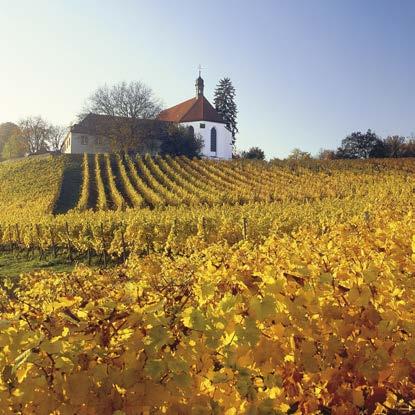
14 minute read
Franken
LAND OF BOCKSBEUTEL
Viticultural Franken is bordered by the Rhön Hills in the north, the Steigerwald (Steiger Forest) in the east, the Tauber River Valley in the south, and the Spessart Hills in the west. The vineyard area is about 6,100 ha (15,073 acres) in size and concentrates around Klingenberg, Würzburg, Volkach and Iphofen. Silvaner, in particular, thrives best in the shell-limestone and keuper (colored and/or gypsum marl) soils, and is the calling card of Franconian winemaking. Finely aromatic Müller-Thurgau is the region’s main varietal and enjoying a renaissance, thanks to a number of young growers who vinify their Müller-Thurgau wines in a contemporary style. Some 80% of all Franconian wines are white. In addition to Silvaner and Müller-Thurgau, Bacchus plays an important role as a regional specialty.
Advertisement
The center of the region is the Baroque and festival performance city of würzburg, with the residenz and medieval Marienberg fortress. Here, too, are famous vineyard sites, such as würzburger Stein – its wines numbered among Goethe’s favorites. würzburg’s great, traditional wine estates, with their vast cellars and impressive architecture, are splendid settings for events. The Baroque Festival, for example, is a perfect
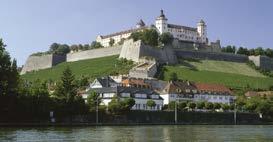
way to sample top Franconian wines with gourmet cuisine. The Franconian people are proud of their rich history. It comes alive every step of the way on a tour through the region. The Middle Ages are ever present, even in smaller, rural Franconian wine towns, such as Miltenberg, Iphofen or Volkach. It’s worth discovering the old town walls, towers, gables and cobblestone streets. Steigerwald villages abound with idyllic half-timbered gems. Also noteworthy: many a Vinothek (wine shop) with wonderful selections of wines on offer, and modern wine architecture – an invitation to experience wine in stylish surroundings, and symbolic of the new era dawning in the region. Franken has a well-trained team of guides to help visitors “experience” wine country and its wines in a charming and creative manner.
one can follow the course of the Main river by cycling along the Main-radweg. The charming scenery of the great loop near Volkach can even be discovered by raft. Covered wagon rides are also possible, and there are fascinating views of the region from the trails along the heights. For young and old alike, it’s always very special to take part in the harvest – a hands on experience from grape to wine. The “last cartload” of grapes marks the end of the harvest and is celebrated with a glass of the “new wine.” Federweisser (grape juice in the process of fermentation) also flows freely at the last wine festivals of the year...but the season begins again as early as the next March. Franken is a region known for its creativity in combining wine, food and culture. Pleasure seekers will find much on offer for unforgettable experiences.
FRANKEN – AT A GLANCE
Geographical location: Between Aschaffenburg and Schweinfurt on the south-facing valley slopes of the Main river and its tributaries · Climate: Predominantly continental climate with dry, warm summers and cold winters · Soils: weathered primitive rock and red sandstone in the Mainviereck district in Lower Franken and the Spessart Hills; loam, loess and shell-limestone in the Maindreieck district near wertheim and Miltenberg; and marl in the Steigerwald district · Size: ca. 6,100 ha (15,073 acres) · Grape varieties: Müller-Thurgau, Silvaner, Bacchus
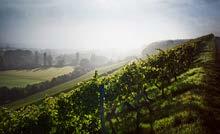
Information: Frankenwein-Frankenland GmbH Hertzstr. 12 97076 würzburg Tel. +49 (0)931 39011-0 www.frankenwein-aktuell.de kontakt@haus-des-frankenweins.de
Wein.Schöner.Land! www.franken-weinland.de
Wine Guides www.gaestefuehrer-weinerlebnis.de
Franken: Landmarks of German Wine Culture
THE WEINREICH IN SOMMERACH, FRANKEN
“Vision Requires Space,” proclaimed the 90 winegrowing families of Franken's oldest winegrowing cooperative. And through “Weinreich” (World of Wine) in the lower Franconian town of Sommerach, that vision has become a reality. As a collective, the Sommerach winemakers believe in combining respect for tradition with an innovative spirit. This philosophical 'blend' is not limited to the wines they produce year-for-year, but is reflected in the redesign of their meeting house as well.
A World of Senses
The tasting room on the ground floor is young, modern and hip. The 'Kostbar' and its staff serve up Franken classics alongside more international varieties.
Included in the wide range of offerings is everything from Silvaner, riesling and Traminer to Pinot, Cabernet and Sauvignon Blanc to regional specialties such as Scheurebe and Bacchus. A staircase bearing the names of the Sommerach winegrowers leads visitors down into the friendly atmosphere of the brightly lit tasting room. The massive vaulted ceilings date back to the founding of the winegrowers cooperative in 1901 and today are used as a quiet place to age the cooperative's red wines and store the finest examples from past vintages. A striking lighting concept among the old split-stone walls plunges the visitor into a subterranean world of light and color: from the dimly lit barrel vaults of the barrique cellar to bright steel tanks illuminated in shimmering rays of violet, pink and orange.
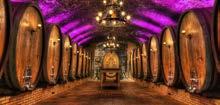
Winzerkeller Sommerach eG Sommerach am Main, Zum Katzenkopf 1 Tel. +49 (0)9381 80610 www.winzer-sommerach.de
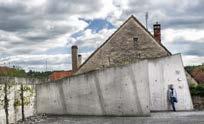
WEINGUT BRENNFLECK IN SULZFELD ON MAIN, FRANKEN
“Sunny, simple and self-assured” is how Susanne and Hugo Brennfleck describe the new cubic architecture of their press house, situated next to the late Medieval estate. The married couple represent the 13th generation of vintners in this family-run winery in the Franconian town of Sulzfeld on Main. The unusual collection of buildings in the historical winemaking village combines a knowledge of history with a certain contemporary spirit – no different than the Brennfleck wines themselves.
Bocksbeutel, Bordeaux and Burgundy Bottles “A single sip will reveal the region, the landscape, the vintage and the winegrower's signature,” Hugo Brennfleck says. Although Silvaner is perhaps the most common variety to be found maturing beneath the estate's historically protected vaulted ceilings (1479), Müller-Thurgau, riesling, weißburgunder (Pinot Blanc), Grauburgunder (Pinot Gris), Bacchus, Scheurebe and Spätburgunder (Pinot Noir), plus dornfelder and domina blends, can be found as well. The press house has been remodeled in a minimalist style, marking a clear – and intentional – departure from its historical context. wood from the estate's grounds, shell limestone from the region and a sober patch of exposed concrete are the key building materials. The design also makes it possible to observe almost the entire winemaking process. “People are really interested in that,” the Brennflecks explain. “The use of top-quality materials and a minimalist aesthetic lends the wine a certain harmony and brings unity to the overall picture.”
Weingut Brennfleck Sulzfeld am Main, Papiusgasse 7 Tel. +49 (0)9321 4347 www.weingut-brennfleck.de
TASTING ROOM AT WEINGUT MAX MÜLLER I, FRANKEN
Receptive to new ideas while simultaneously rooted in tradition – that's the heart of the matter for Monika and Rainer Müller. Together with their family, the pair operates Weingut Max Müller I in the Franconian town of Volkach. Despite the massive Baroque masonry, their brightly lit tasting room radiates a warmth, liveliness and welcome that is anything but pretentious.
Awash in Light and Inspiration This blend of tradition and innovation shapes the Franconian estate's wine portfolio as well. “Neues Franken” is a range of lovely, lively and fresh wines – while “Klassisches Franken” features more sophisticated premium bottles grown in the best sites around Volkach. The vineyards along the river bow called the Mainschleife are known for their extreme steepness (up to 70 percent) and are planted with an assortment of vines including Silvaner, riesling, rieslaner, Müller-Thurgau, Scheurebe, weißburgunder (Pinot Blanc), domina und Spätburgunder (Pinot Noir). The Müllers' innovations extend into the vineyard as well. Their prized “Volkacher ratsherr” site for example is host

to a team of “French guest workers from the organic industry”: a tongue-in-cheek description for the Breton pygmy sheep who happily munch back the canopy on the steep slopes above the Main. They enthusiastically maintain order among the vines and provide proper ventilation for the grapes.
Weingut Max Müller I Volkach, Hauptstraße 46 Tel. +49 (0)9381 1218 www.max-mueller.de
WÜRZBURGER WEINGUT AM STEIN, FRANKEN
Ludwig Knoll chose the name “WeinWerk” (WineWorks) for the tasting room at his Weingut am Stein. He and his family are the fifth generation to run the Würzburg estate. Even during the day, the views from its renowned vineyards over the old city, the Marienberg fortress, the central Main Valley and the vine-covered slopes of the Maindreieck area are majestic. Yet the real highlight comes after nightfall. Then the illuminated facade of the WeinWerk stands out vividly against the dark sky above a city that was once the seat of royalty.
A Ray of Light above Würzburg Inspired by the vines in the surrounding vineyards, the exact geometric cube of the weinwerk is an imposing and recognizable landmark high above würzburg. wooden bars stretch vertically like a loose curtain in front of the green tinted glass walls. From a design standpoint, they break up the building's monolithic character, without masking the transitions between floors.
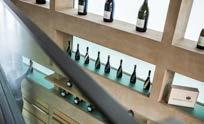
Behind the façade is space for tastings, presentations and seminars. For those inside the building, the tinted glass and wood create a captivating light show that changes as the sun moves across the sky. what doesn't change is the outstanding quality of the estate's wines. Its most important varieties include Silvaner, riesling and assorted Pinots, as well as modern crossings such as Müller-Thurgau, Scheurebe, rieslaner and Bacchus.
Weingut am Stein würzburg, Mittlerer Steinbergweg 5 Tel. +49 (0)931 25808 www.weingut-am-stein.de
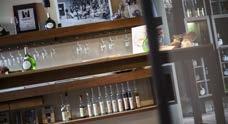
THE VINOTHEK IPHOFEN, FRANKEN
This wine tasting room is a telling reflection of the region’s vintners: self-confident, grounded and internationally minded. In a successful, albeit unusual, ensemble of traditional and modern architecture, the historically protected red stucco building with bluegray shutters sits next to a transparent steel & glass construction. It is located at the center of this Franconian winegrowing village, between the Baroque city hall and the St. Veit Stadtpfarrkirche (Parish Church). Open to the World, but Proud of Home The story of the Vinothek Iphofen begins with the two-storey, 17th century stucco building that was once home to the church's sexton. A new wing was built next to it in 2000, and is now used by Iphöfer vintners as a space in which to present their white, red, rosé and sparkling wines, as well as their liqueurs and spirits.
The building's constructors opted for local materials, such as Iphöfer red oak – a wood whose warm and inviting coloration can be attributed to the minerality in the soil. despite the contrast in styles, the historic Baroque property and the richly lit glass/steel annex make a wonderful pair. They surround a sunny inner courtyard that invites visitors to linger. In total, the building complex covers 600 square meters (6,458 square feet) of floor space across four levels. A bistro, tourist information office, gallery for a rotating set of art exhibits and conference and seminar rooms can also be found on the premises.
Vinothek Iphofen Iphofen, Kirchplatz 7 Tel. +49 (0)9323 870317 www.vinothekiphofen.de
THE STAATLICHE HOFKELLER AT THE WÜRZBURG RESIDENZ, FRANKEN
“There is to be no quarreling, cursing, bawdy humor, long-windedness, scratching, writing on the walls, knocking on the cask with hands, cheekiness or other nonsense, as these will not be tolerated here!” So read the historical Rules of the Cellar, a centuries-old code of conduct posted at the entrance to the Staatlichen Hofkeller Würzburg. With that settled, visitors are invited to explore the subterranean labyrinth of vaults and cellars beneath the Würzberg Residence.
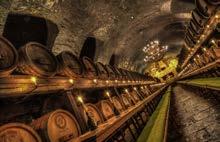
Baroque and Barrique In Anno domini 1719, würzburg Prince-Bishop Johann Philipp Franz von Schönborn commissioned Baroque master builder Balthasar Neumann to create a castle and grounds befitting his rank, including a firstclass wine cellar. This latter request was built into the residence's very foundations. even today fine wines from the top sites around würzburg, the Steiger Forest, the Lower Main and the Mainviereck are aged within the powerful vaults and the 6-meter (20 ft) thick masonry walls. Almost 900 meters (2950 ft) of passageways connect the various cellar areas that range across 4500 square meters (48,500 square ft), all measuring between 15 and 18°C (59 to 64°F). This includes a functionary's wine cellar in which the liquid salary for the royal household was stored in three giant casks, and the oval rondel cellar with its powerful rounded central pillar, considered Balthasar Neumann's masterpiece of engineering construction. The former ice cellar is currently used for aging high-quality red wines in barrique barrels.
Staatlicher Hofkeller Würzburg, Rosenbachpalais würzburg, residenzplatz 3 Tel. +49 (0)931 3050923 www.hofkeller.de
THE BÜRGERSPITAL ZUM HEILIGEN GEIST IN WÜRZBURG, FRANKEN
When in 1726 the City of Würzburg declared war on the adulteration of wine, the city's aldermen decreed that the exquisite Steinwein from the 1718 vintage should be filled in glass Bocksbeutel bottles. The canteen-shaped bottles were sealed with the city's arms and stored in the cellar of the Bürgerspital. Not long thereafter the practice of using the Bocksbeutel expanded to include other fine Franken wines. Since then the distinctive bottle has served as a hallmark of Franken wines classified as “Qualität“ or “Prädikat.”
Pot-bellied Bottles in the Bürgerspital The Bürgerspital zum Heiligen Geist was a charitable institution founded in the early 14th century by an affluent würzburg patrician concerned with improving care for the impoverished. revenues from agriculture and the vineyards were used to support the Spital's operation. each inhabitant of the Spital received a daily allotment of wine based on their behavior. According to records from 1598, those who followed the rules were given the full 1.2 liters. Those
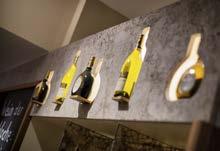
who fell out of line were punished with diluted wine; more serious transgressions meant no wine whatsoever. The foundation's resources are still dependent on revenue from the properties it owns. For example, a portion of the proceeds from every bottle the winery sells nowadays goes to the organization's institutions, including residential and senior homes for over 750 persons. The Bürgerspital itself is now used as a geriatric rehabilitation clinic treating roughly 500 patients each year.
Bürgerspital zum Heiligen Geist, Weingut würzburg, Theaterstraße 19 Tel. +49 (0)931 3503441 www.buergerspital.de
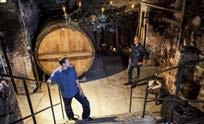
THE WÜRZBURGER JULIUSSPITAL, FRANKEN
It can get mighty loud when wine casks are rolled down the long arcaded passageways of this princely building, but otherwise the prevailing atmosphere within the inner courtyard of the Juliusspital is one of quiet contemplation. In addition to the hospital, palliative care academy, seniors home and vocational schools, this important foundation also owns Germany's second largest winemaking estate, originally founded by Prince-Bishop Julius Echter von Mespelbrunn on 12 March 1576. Rolling with the Times The founding documents for the Juliusstift from 1579 entrust it to provide care for “all manners of poor” and “damaged folk who need tending to wounds,” as well as “orphans” and traveling pilgrims. The Prince-Bishop, for whom the Juliusspital is named, endowed his foundation with forests and estates, including vineyards in all sections of the Franconian winegrowing region. Many of these same vineyards are now counted among Germany's most prized sites: würzburger Stein, Iphöfer Julius-echter-Berg, Volkacher Karthäuser, randersackerer Pfülben, rödelseer Küchenmeister and escherndorfer Lump. weingut Juliusspital today oversees 177 hectares (437 acres) and, despite its historic setting, has been supplemented with cutting-edge computer technology and giant stainless steel tanks. wines mature in 220 large and small oak casks stored under the vaulted ceilings of its 250-meter (820 ft) long cask cellar.
Weingut Juliusspital würzburg, Klinikstraße 1 Tel. +49 (0)931 3931400 www.juliusspital.de
THE FÜRSTLICH CASTELL’SCHE DOMÄNENAMT IN CASTELL, FRANKEN
Ferdinand Graf zu Castell-Castell casts a watchful eye over the newly planted hillside vineyard on the western edge of the Steiger Forest. It will take three or four years before the first grapes are ready, but no one is concerned. Time is relative at the Fürstlich Castell’schen Domänenamt, where the oldest recorded mention of vineyards dates back to 1224 and the actual winemaking tradition of the House of Castell likely stretches beyond even that.
An Eye on Silvaner In 1659 wolfgang dietrich zu Castell, forefather to the current family members, ordered the first Silvaner shoots to be planted on German soil at the Casteller Schlossberg. The grape variety at the time was known as “Österreicher” (Austrian), where it most likely origi-
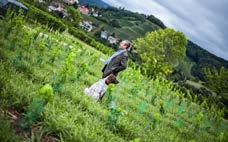
nated. only ten years later, 10,000 Silvaner vines were counted in Castell-controlled districts. Today, with 40 percent of the Fürstlich Castell’schen domänenamt vineyards dedicated to Silvaner, the hardy variety continues to play a significant role in both the estate and the region. The vines' robustness against early spring frosts has contributed significantly to its success in Franconian viticulture. But the tale doesn't end there: a variety that began as a local success story in Castell – the cradle of Silvaner – has gone on to thrive in numerous German winegrowing regions as well.
Fürstlich Castell’sches Domänenamt Castell, Schlossplatz 5 Tel. +49 (0)9325 60160 www.castell.de










